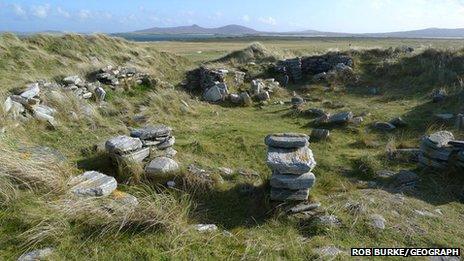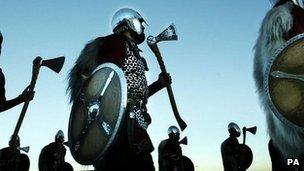New study of Western Isles' sand dune-buried artefacts
- Published

Remains of Iron Age occupation of the site on North Uist
New research is being carried out on artefacts recovered from a site where evidence was found for every age from the Neolithic to the 20th Century.
Archaeology at Udal provides an "unbroken timeline" of occupation from the Neolithic, Bronze Age, Iron Age, Viking, Medieval through to the 1900s.
Some of the evidence at the site on North Uist was preserved by wind-blown sand dunes.
Archaeologist Ian Crawford excavated Udal between 1963 and 1995.
The earliest Neolithic layers he revealed consisted of a line of stones with a large upright stone nicknamed the great auk stone because of its resemblance to the extinct seabird.
A deep shaft containing quartz pebbles which had been covered over with a whale's vertebrae was also uncovered.
From the Bronze Age, finds included a skeleton and from the Iron Age evidence of metal work.
Also from the Iron Age were the remains of homes dubbed Jelly Baby houses because the shape of them looked like the sweets.
Evidence of a Viking longhouse and later occupation during the 1600s through to the 18th and 19th centuries were also found.
From the early 20th Century was a saw pit for cutting up wrecked boats.
Crawford's collection is in the care of Western Isles local authority, Comhairle nan Eilean Siar.
The comhairle believes the site on the Grenitote peninsula to be one of the most important of its kind in the world.
It said the preservation of relics by being buried under sand was rare outside of the Middle East.
The comhairle has received £85,000 from the Museum Association's Esmee Fairbairn Collections Fund to carry out the most complete post-excavation research to be done so far on the site and its finds.
Historic Scotland is assisting with the study.
Money from the grant will also be used to investigate the potential for an archaeological resource centre on North Uist.

Evidence of Viking occupation included a longhouse
Councillor Archie Campbell said the £85,000 grant would help islanders and the comhairle achieve a vision.
He said: "The local community has been waiting nearly 50 years to learn about what was discovered beneath the sand dunes and to see the finds for themselves.
"Long before the material was released by Ian Crawford the community made it clear that their wish was for the collections to be returned to the islands on a permanent basis.
"This grant will go towards achieving that vision by funding a feasibility study into the potential of the Udal collections as the basis for an archaeological resource centre and the impact it would have on the islands' economy."
Deborah Anderson, regional archaeologist with the comhairle, welcomed the funding towards better understanding the collection.
She said: "This is an assemblage which is not just important to the Outer Hebrides but which is essential to help date other collections from the west coast of Scotland and Ireland.
"The local community will no doubt be thrilled that we have received this grant, and we are one step closer to understanding what was discovered beneath the sand dunes."
- Published8 September 2011
- Published13 July 2011